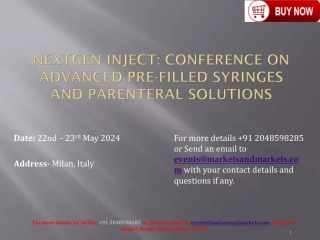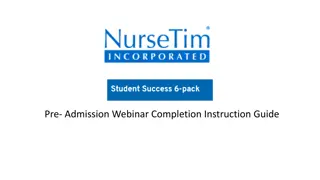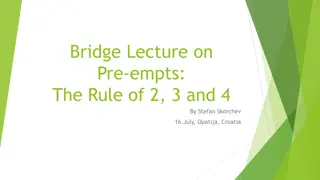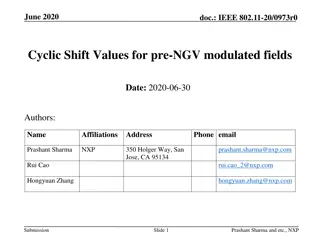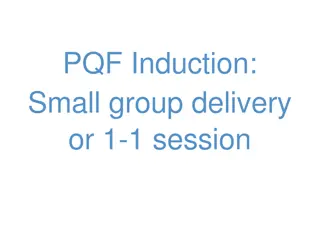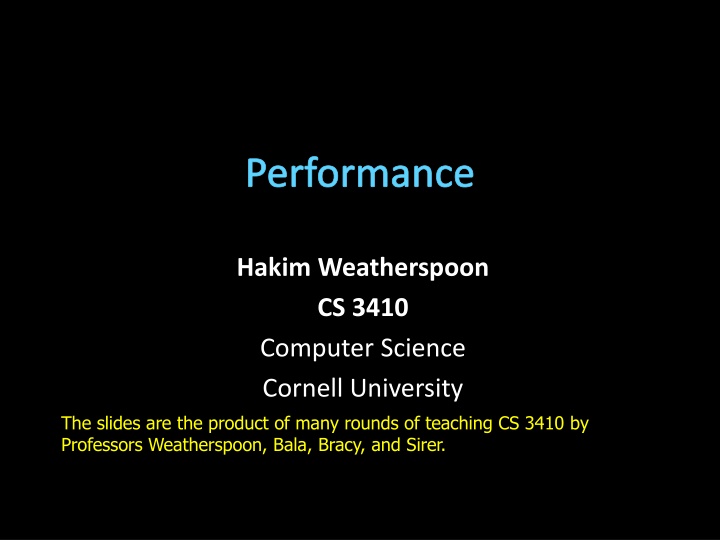
Performance Metrics in Computer Science
Explore the intricacies of performance metrics in computer science, covering topics such as clock speed, CPI, throughput, and latency. Learn how various measures affect overall system performance and decision-making processes in selecting processors. Delve into the complexities of gauging and optimizing performance in computing environments.
Download Presentation

Please find below an Image/Link to download the presentation.
The content on the website is provided AS IS for your information and personal use only. It may not be sold, licensed, or shared on other websites without obtaining consent from the author. If you encounter any issues during the download, it is possible that the publisher has removed the file from their server.
You are allowed to download the files provided on this website for personal or commercial use, subject to the condition that they are used lawfully. All files are the property of their respective owners.
The content on the website is provided AS IS for your information and personal use only. It may not be sold, licensed, or shared on other websites without obtaining consent from the author.
E N D
Presentation Transcript
Performance Hakim Weatherspoon CS 3410 Computer Science Cornell University The slides are the product of many rounds of teaching CS 3410 by Professors Weatherspoon, Bala, Bracy, and Sirer.
Goals for today Performance What is performance? How to get it?
Performance Complex question How fast is the processor? How fast your application runs? How quickly does it respond to you? How fast can you process a big batch of jobs? How much power does your machine use?
Measures of Performance Clock speed 1 KHz, 103 Hz: cycle is 1 millisecond, ms, (10-6) 1 MHz, 106 Hz: cycle is 1 microsecond, us, (10-6) 1 Ghz, 109 Hz: cycle is 1 nanosecond, ns, (10-9) 1 Thz, 1012 Hz: cycle is 1 picosecond, ps, (10-12) Instruction/application performance MIPs (Millions of instructions per second) FLOPs (Floating point instructions per second) GPUs: GeForce GTX Titan (2,688 cores, 4.5 Tera flops, 7.1 billion transistors, 42 Gigapixel/sec fill rate, 288 GB/sec) Benchmarks (SPEC)
Measures of Performance CPI: Cycles per instruction Cycle/instruction for onaverage IPC = 1/CPI Used more frequently than CPI Favored because bigger is better , but harder to compute with Different instructions have different cycle costs E.g., add typically takes 1 cycle, divide takes >10 cycles Depends on relative instruction frequencies CPI example Program has equal ratio: integer, memory, floating point Cycles per insn type: integer = 1, memory = 2, FP = 3 What is the CPI? (33% * 1) + (33% * 2) + (33% * 3) = 2 Caveat: calculation ignores many effects Back-of-the-envelope arguments only 5
Measures of Performance General public (mostly) ignores CPI Equates clock frequency with performance! Which processor would you buy? Processor A: CPI = 2, clock = 5 GHz Processor B: CPI = 1, clock = 3 GHz Probably A, but B is faster (assuming same ISA/compiler) Classic example 800 MHz PentiumIII faster than 1 GHz Pentium4! Example: Core i7 faster clock-per-clock than Core 2 Same ISA and compiler! Meta-point: danger of partial performance metrics! 6
Measures of Performance Latency How long to finish my program Response time, elapsed time, wall clock time CPU time: user and system time Throughput How much work finished per unit time Ideal: Want high throughput, low latency also, low power, cheap ($$) etc.
How to make the computer faster? Decrease latency Critical Path Longest path determining the minimum time needed for an operation Determines minimum length of clock cycle i.e. determines maximum clock frequency Optimize for latency on the critical path Parallelism (like carry look ahead adder) Pipelining Both
Latency: Optimize Delay on Critical Path E.g. Adder performance 32 Bit Adder Design Space Time Ripple Carry 300 gates 64 gate delays 2-Way Carry-Skip 360 gates 35 gate delays 3-Way Carry-Skip 4-Way Carry-Skip 500 gates 600 gates 22 gate delays 18 gate delays 2-Way Look-Ahead 550 gates 16 gate delays Split Look-Ahead Full Look-Ahead 800 gates 1200 gates 10 gate delays 5 gate delays
Review: Single-Cycle Datapath + 4 Register File s1 s2 d I$ PC D$ Single-cycle datapath: true atomic F/EX loop Fetch, decode, execute one instruction/cycle + Low CPI (later): 1 by definition Long clock period: accommodate slowest insn (PC I$ RF ALU D$ RF) 10
New: Multi-Cycle Datapath + 4 A Register File s1 s2 d I$ PC O D B D$ Multi-cycle datapath: attacks slow clock Fetch, decode, execute one insn over multiple cycles Allows insns to take different number of cycles Opposite of single-cycle: short clock period, high CPI 11
Single- vs. Multi-cycle Performance Single-cycle Clock period = 50ns, CPI = 1 Performance = 50ns/insn Multi-cycle: opposite performance split + Shorter clock period Higher CPI Example branch: 20% (3 cycles), ld: 20% (5 cycles), ALU: 60% (4 cycle) Clock period = 11ns, CPI = (20%*3)+(20%*5)+(60%*4) = 4 Why is clock period 11ns and not 10ns? Performance = 44ns/insn Aside: CISC makes perfect sense in multi-cycle datapath
Multi-Cycle Instructions But what to do when operations take diff. times? E.g: Assume: load/store: 100 ns arithmetic: 50 ns branches: 33 ns ms = 10-3 second us = 10-6 seconds ns = 10-9 seconds ps = 10-12 seconds 10 MHz 20 MHz 30 MHz Single-Cycle CPU 10 MHz (100 ns cycle) with 1 cycle per instruction
Multi-Cycle Instructions Multiple cycles to complete a single instruction E.g: Assume: load/store: 100 ns arithmetic: 50 ns branches: 33 ns ms = 10-3 second us = 10-6 seconds ns = 10-9 seconds ps = 10-12 seconds 10 MHz 20 MHz 30 MHz Which one is faster: Single- or Multi-Cycle CPU? Multi-Cycle CPU 30 MHz (33 ns cycle) with 3 cycles per load/store 2 cycles per arithmetic 1 cycle per branch Single-Cycle CPU 10 MHz (100 ns cycle) with 1 cycle per instruction
Cycles Per Instruction (CPI) Instruction mix for some program P, assume: 25% load/store ( 3 cycles / instruction) 60% arithmetic ( 2 cycles / instruction) 15% branches ( 1 cycle / instruction) Multi-Cycle performance for program P: Multi-Cycle @ 30 MHz Single-Cycle @ 10 MHz
Total Time CPU Time = # Instructions x CPI x Clock Cycle Time sec/prgrm = Instr/prgm x cycles/instr x seconds/cycle Instructions per program: dynamic instruction count Runtime count of instructions executed by the program Determined by program, compiler, ISA Cycles per instruction: CPI (typical range: 2 to 0.5) How many cycles does an instruction take to execute? Determined by program, compiler, ISA, micro-architecture Seconds per cycle: clock period, length of each cycle Inverse metric: cycles/second (Hertz) or cycles/ns (Ghz) Determined by micro-architecture, technology parameters For lower latency (=better performance) minimize all three Difficult: often pull against one another
Total Time CPU Time = # Instructions x CPI x Clock Cycle Time sec/prgrm = Instr/prgm x cycles/instr x seconds/cycle E.g. Say for a program with 400k instructions, 30 MHz: CPU [Execution] Time = ?
Example Goal: Make Multi-Cycle @ 30 MHz CPU (15MIPS) run 2x faster by making arithmetic instructions faster Instruction mix (for P): 25% load/store, CPI = 3 60% arithmetic, CPI = 2 15% branches, CPI = 1
Example Goal: Make Multi-Cycle @ 30 MHz CPU (15MIPS) run 2x faster by making arithmetic instructions faster Instruction mix (for P): 25% load/store, CPI = 3 60% arithmetic, CPI = 2 15% branches, CPI = 1 Goal: Make processor run 2x faster, i.e. 30 MIPS instead of 15 MIPS
Amdahls Law Amdahl s Law Execution time after improvement = execution time affected by improvement + execution time unaffected amount of improvement Or: Speedup is limited by popularity of improved feature Corollary: Make the common case fast Don t optimize 1% to the detriment of other 99% Don t over-engineer capabilities that cannot be utilized Caveat: Law of diminishing returns

